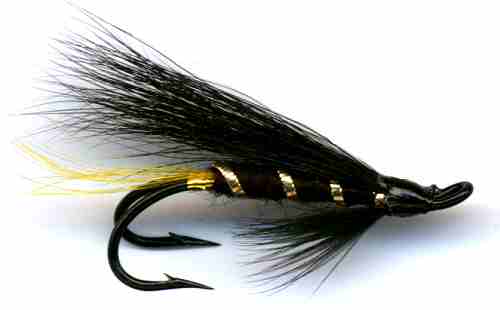The Stoat's Tail Double Hook Salmon Fly
The Stoat's Tail or Black Bear Double Hook Salmon fly is a very effective solid, dependable, traditional salmon and sea trout pattern. This fly derived its name from the fact that it was first winged with the black tip of a stoats tail, now dyed bucktail is preferred.

SALMON DOUBLE HOOK FLY PATTERNS. Hook size 4 6 8 10 - $US each
The dark silhouette it creates works in crystal clear summer level water as well as the colored water of a spring flood.s The North American steelhead Black Bear fly has more than a passing resemblance to the Stoat's tail. It is a good bet when the fish refuse the more gaudy patterns and during times of low water disinterested fish. There is debate over it's origins. In "Trout and Salmon Flies" by Sutherland and Chance it is listed as originating at Park on the river Dee in Scotland. In the "Encyclopedia of Fly Fishing" by Conrad Voss Bark the Stoats tail is credited to James Wright of Sprouston-on-Tweed (Scotland) made during 1870-80's. Nowadays it is given a dyed bucktail or black squirrel wing. The salmon do not appear to notice the difference as it is still a very productive salmon fly. This black fly can be irresistible to salmon, Steelhead and sea trout in difficult summer conditions of high water temperature and low levels. It is also very popular in big clear water rivers. This fly will take both "stale" and "fresh" fish in all hook sizes and weather conditions. It is a good all-round fly.
Over the years there has been a radical change in the way salmon flies are tied. At first feathers were used but over the past 50 years have wing salmon flies have been the norm rather than further wingrd salmon flies. They are more robust and present a slimmer profile when wet and pulled on the retrieve. The fibres used in a hair wing salmon fly have a more natural movement quality when wet compared with the traditional feather wing fly patterns. When you observe a salmon move out of its lie and head towards your fly and then drop back again, having reached within a foot of your fly, you know that is when you need to change what is on the end fishing line
A drab salmon fly pattern like the Stoat’s Tail is a more productive choice in clear water conditions when the water temperature is warming up as you will find in late spring, the summer and early fall. I like to use the Stoats tail in low water conditions in high summer on a hook size 10. Some salmon anglers swear by the Stoat’s Tail fly pattern. They find it is their most productive fly. Some have suggested that if they used nothing but a Stoats Tail fly all year, in suitable sizes and weights, it would catch just as many fish compared to a year of using a selection of different salmon flies. That would be a good experiment. If you regularly went fishing with a friend over the course of a year; one of you would only use a Stoat’s tail fly and the other use a variety of flies to match the conditions. If you take up this challenge please let me know the result.
CUSTOMER'S COMMENT
I was fishing for trout on the river Usk. It was near dusk. The river was low. I knew there may be a chance of some sea-trout so I tied on a small Stoats Tail. I felt a solid draw on my line and after a 15 minute fight landed a 12 lb salmon. I later caught three Brown trout around the 1 lb mark and a larger chub. What a fly! Hugh Montgomery

